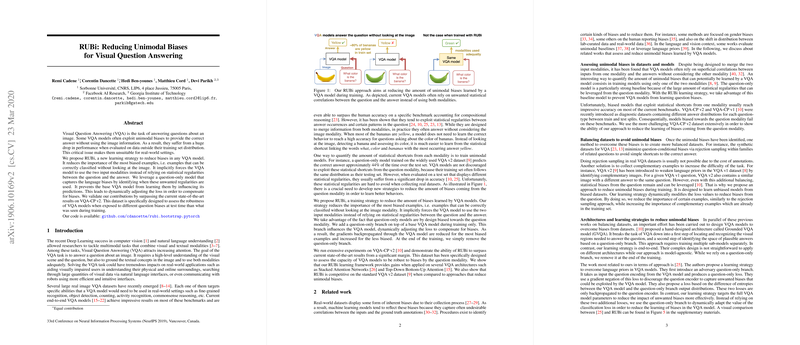An Examination of RUBi: A Strategy to Mitigate Unimodal Biases in Visual Question Answering
The research paper titled "RUBi: Reducing Unimodal Biases for Visual Question Answering" presents a novel approach aimed at addressing one of the longstanding limitations in Visual Question Answering (VQA) systems: the tendency of such systems to rely heavily on language or question-based biases rather than integrating information across both visual and textual inputs. The authors introduce and elaborate on the RUBi (Reducing Unimodal Bias) method, which can be integrated into existing VQA models to enhance their robustness and generalization capabilities, particularly when confronted with datasets that have distributions differing from those encountered during training.
Overview of the Approach
VQA systems typically combine image and language processing to answer questions based on visual data. However, many models exploit statistical regularities within the question modality, often neglecting crucial visual information. This tendency is problematic, especially when models are deployed in real-world scenarios that differ significantly from the static and potentially biased training datasets.
RUBi addresses this issue by incorporating a question-only branch into existing VQA architectures during training. This branch identifies and captures the biases present in the questions. By doing so, it influences the main VQA model's parameter optimization process to discount these biases, effectively preventing the model from overfitting to the language component alone. The strategy involves modifying the standard loss function such that examples which could be biasedly predicted are down-weighted, encouraging the model to rely more on visual information.
Experimental Validation
The efficacy of RUBi is validated through extensive experiments on the VQA-CP v2 dataset, which is specifically designed to measure models' robustness against question biases. The results are compelling: RUBi, when applied to a baseline VQA model, leads to an increase in overall accuracy from 38.46% to 47.11%. This improvement represents a substantial gain over the baseline and also surpasses previously reported state-of-the-art results, achieving a gain of +5.94 percentage points. Moreover, RUBi shows consistent performance enhancements across different architectures, such as SAN and UpDn, further demonstrating its flexibility and effectiveness in reducing unimodal biases.
Implications and Future Directions
The introduction of RUBi has substantial implications for the field of VQA and multimodal machine learning. By mitigating reliance on language biases, models trained with RUBi are more likely to generalize well to new datasets, leading to more reliable VQA systems in practical applications. This advancement paves the way for more equitable AI systems, as it minimizes model decisions based on dataset-specific bias, which is crucial in diverse real-world applications.
From a theoretical perspective, RUBi raises interesting questions about the interplay between different modalities in neural networks and how biases in these can be systematically identified and reduced. The method's reliance on dynamic loss adjustment is particularly noteworthy, hinting at broader applications in other domains where similar biases exist, such as sentiment analysis or recommendation systems.
Future research might explore the extension of RUBi to other tasks within multimodal learning and its integration with more complex architectures like transformer-based models, which have shown promise in overcoming similar unimodal bias issues. Additionally, the potential for RUBi to improve grounding and attention mechanisms in VQA models, as hinted by preliminary qualitative results, suggests a rich avenue for further inquiry.
In conclusion, the RUBi learning strategy addresses a critical challenge in VQA by offering a robust and adaptable solution to reduce unimodal biases. The methodological innovation and the substantial performance gains observed suggest that RUBi will serve as an important tool in the ongoing development of more versatile and fair AI systems.
